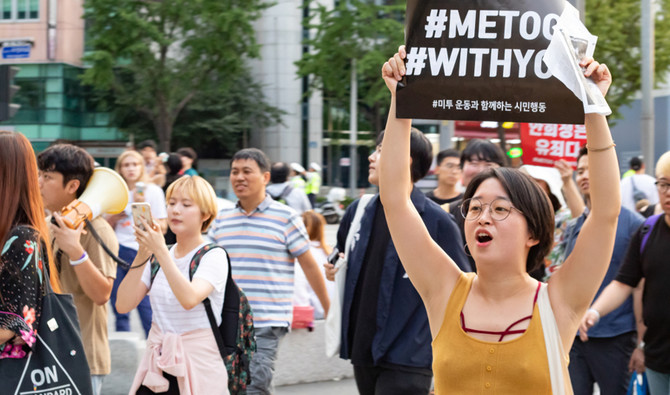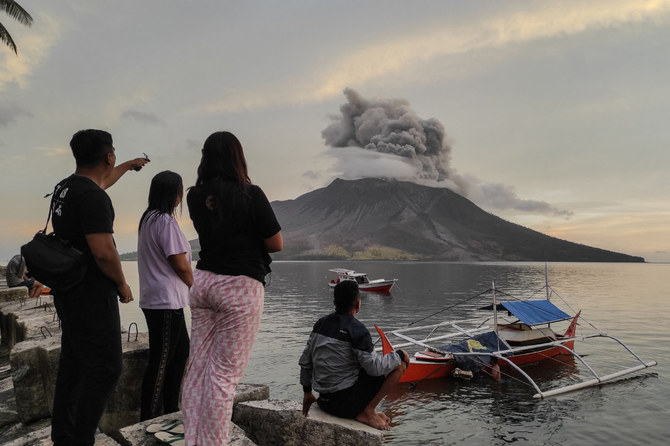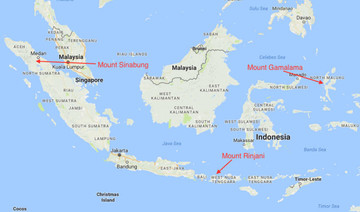SEOUL: Park Ju-yeon, a 17-year-old high school student, has complained of nightmares for a long time, ever since she was molested by a teacher three years ago when she was in middle school.
At the time, she appealed in vain to the school and police for help.
Today, she says she’s willing to take the risk of being identified as a victim after being inspired by hundreds of others who are taking part in rallies to raise voices against widespread sexual abuse and harassment at schools. They are part of the #SchoolMeToo campaign, the latest to branch out from the global #MeToo movement.
“The school asked me to keep quiet and not to make big trouble, and the police were not willing to investigate the case in an active manner,” Lee told Arab News. “The #MeToo movement, however, has changed the atmosphere definitely, and I decided to speak out.”
The #SchoolMeToo campaign is increasingly gaining momentum with students from nearly 80 middle and high schools across the nation rallying against sexual harassment and calling for those responsible to be taken to task.
According to Twitter Korea, the #SchoolMeToo topped the list as the most tweeted word in 2018, as the #MeToo movement has taken a surprising hold in South Korea, a socially conservative country, over the past year.
Almost every week, women demonstrators take to the streets in central Seoul to protest against sexual abuse and harassment.
“#MeToo injected a new life into the feminist movements in this patriarchal society,” Lee Na-young, professor of sociology at the ChungAng University in Seoul, said in a phone interview.
“South Korean women activists played a key role in fights for preserving the nation’s democracy and liberty for a long time. Their historic and systematic efforts are exploding now after meeting a new wave of feminist movements like #MeToo.”
The professor added that there are two forces at work — the young generation of women and social network service (SNS), referring to the 2016 murder of a woman in a public bathroom near a subway exit in the upscale district of Gangnam, which became a catalyst for re-energizing the women’s movement in the country.
The killer told the police he did it because women ignored him all the time, sparking outrage over hate crimes against women.
“Since the incident, young women have been more aware of their rights and are keen to be assertive. In particular, they’re effective in drawing out a feminist agenda online through SNS,” Lee said.
The rising tide of the #MeToo movement has brought down a number of prominent figures in South Korea.
Recently, former governor Ahn Hee-jung of South Chungcheong Province, who was widely seen as a strong candidate to replace President Moon Jae-in, was found guilty of abuse of authority on Feb. 1 over charges which included sexual intercourse with his former secretary after she went public with her ordeal.
Similarly, prominent movie stars and directors, including Kim Ki-duk who won a Golden Lion at the Venice Film Festival, were named and shamed, while famous poet Ko Un, once tipped for the Nobel Prize for Literature, was accused of sexually harassing female literary hopefuls.
An anti-spycam movement has helped the cause. Secret cameras in public places such as toilets and changing rooms are a serious problem in tech-savvy South Korea with thousands of women falling prey to what women activists term “digital sex crimes.” Such videos are often uploaded online without the knowledge and consent of the victims.
Since 2005, a small group of women activists has led the “Digital Sexual Crime Out” campaign and their efforts bore fruit recently, leading to a revision of laws.
“A key success was to revise a law to strengthen penalties for those who film spy cams and distribute videos filmed by covert devices though there is a still long way to go,” Lee Han-ki, a female activist from the anti-spycam group, said.
Under a revised law passed last November, violators face up to five years in prison or a fine of up to $26,000.
Earlier, those who filmed indecent videos and distributed them without consent faced up to five years in prison or a fine of up to $88,000. For those indulging in other crimes — such as when the perpetuator films his or her partner naked or during sexual intercourse and uploads it without consent faces up to three years in prison and nearly $4,500 in fine.
“This (Digital Sexual Crime Out) campaign is not for a battle against men. This is for the women’s rights,” Lee said. “What we want is to change the way our society treats women.”
Another emerging feminist movement in South Korea is the so-called “escape the corset” campaign where women give up makeup and cut their hair short to rebel against long-held ideals of beauty.
Thousands of posts on social media show women smashing their cosmetic kits to demonstrate their rejection of a beauty regimen. The phenomena is an interesting development in South Korea, a country that actively promotes its prowess in cosmetic surgery and is known for a thriving makeup culture dubbed “K-beauty,” in tandem with the popularity of Korean girl bands.
“It’s about our choice. This movement is about changing our daily culture and to get greater gender equality,” Jung Ji-soo, a 25-year-old job seeker, said, referring to South Korean society’s rigid standards of beauty.
Feminist movements on a wide range of social issues are expected to grow further in South Korea, where severe gender inequality exists in spite of social democratization and economic development.
“In South Korea’s economic development process, there has been a trickle-down effect for certain generations and groups mostly dominated by men,” Professor Lee said. “The current boom of the women’s movement is in rebellion against long-lasting problems. In the long-run, this South Korean trend will be an exemplary model for other societies.”
According to the Global Gender Gap Report 2018 released by the World Economy Forum (WEF), South Korea ranked 115 among 149 countries on gender equality.
Women in South Korea earn only 63 percent of men’s salaries, one of the highest pay gaps among 29 developed nations. The opportunity for South Korean women’s economic activity was 53 percent, well below the world average of 63 percent.

























